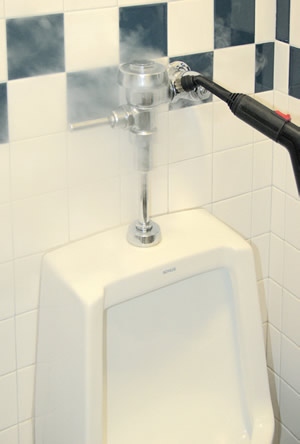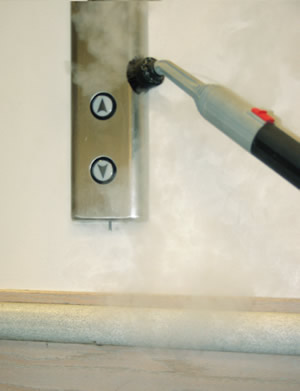Germs on Campus: And What to Do About Them
- By Allen P. Rathey
- 12/01/16

PHOTO © TANCS®-ADVANCED VAPOR TECHNOLOGIES
Germs are not the enemy.
They are essential to our survival.
We host billions of bacteria inside
and outside our bodies (e.g., in the gut and
on the skin) that help to keep us healthy. In
addition, microbes consume organic matter;
without them, Earth would be buried in
biowaste, and life as we know it would cease.
Still, wherever possible, we should reduce,
remove or destroy harmful germs or
pathogens before they pose a health threat
or reach an “infectious dose” level.
Infectious levels of fecal bacteria,
MRSA, staph and other pathogens are common
in campus environments, creating a
need for awareness and remedial action.
Understanding Infectious Dose
Infectious Dose (ID) is the number of
pathogenic germs entering the body that are
needed to make a person sick. This varies
from person to person, based on genetics,
immune system status and other factors.
ID level is unique to an individual, and
explains why some people get sick while
others do not when facing the same exposure.
Still, decreasing pathogen numbers
helps protect all, as well as those who are
especially vulnerable.
What is the best way to reduce pathogen
levels? Start by finding where harmful
germs thrive, then weigh the benefits, risks
and costs of different interventions.
Finding Pathogen “Petri Dishes”
Citing a prime location for germs,
Lisette LeCorgne — nurse practitioner at
the University of Arizona, quoted by Fox
News — said it well: “Living in a dorm
room is like living in a petri dish.”
There can be many pathogen “petri
dish” places on campus, locations with
enough moisture, warmth and a food
source to grow abundant germs.
Start with Hands and Touch Points
Warm, normally-moist hands invariably
touch contaminated spots — and
when unwashed — harbor and grow
germs, then transfer them to touch points,
or, worse, directly to eyes, nose or mouth
(which is why frequent hand washing is
always a recommended strategy.)
Touch points include door handles, sink
handles, desktops, shared computer or tablet
surfaces, dorm refrigerator handles, TV
remote controls and other contact spots.
Dr. Charles Gerba, a microbiologist and
professor at the University of Arizona, is fond
of saying the sink is often more contaminated
than the toilet seat. This is because moisture
and food are abundant on sinks that stay warm
inside conditioned buildings. People also touch
sink surfaces more than they do toilet seats.
Communal showers are germ zones
as they are warm, moist, and loaded with
body oils, skin flakes and fungal spores
like those that cause Athlete’s foot.
Gym and wrestling mats are exposed
to sweat, hot athletic bodies, and sloughed
off skin cells, providing excellent growth
media for MRSA.

PHOTO © TANCS®-ADVANCED VAPOR TECHNOLOGIES
Remove Germs
Good personal hygiene involves washing
hands with soap and water, then drying hands
thoroughly. The focus is on removing germs
and conditions promoting germ growth.
Applying the principle to facility hygiene,
cleaning is the first line of defense, as removing
germs is better than killing them.
Proper cleaning removes organic soil
(aka, germ food), which is why measuring for post-cleaning ATP (Adenosine Triphosphate) levels — using
an ATP meter — as an indicator of organic soil on surfaces is part
of emerging cleaning standards (e.g., ISSA’s) addressing hygienic
outcomes.
When to Use Chemistry
EPA-registered disinfectants are necessary at times, but are
only effective when used as directed, with the proper pre-cleaning
and dwell time (how long the surface must stay wet with the germicide
to kill germs as claimed). Sadly, these products are rarely
used as directed, which should prompt follow up training and
consideration of alternatives.
Removal Approaches
- A squeegee on desks or counters — apply solution directly to the
surface using a course sprayer or heavily-moistened microfiber
pad on a hand trowel. Squeegee off the moisture, carrying away
soil and germs in the solution. This method is effective at removing
germ-containing or -promoting soils.
- Spray-and-vacuum units apply cleaning solution under moderate
pressure, enable agitation, then vacuum the liquid along with
germs, leaving the surface virtually dry.
Better Ways to Disinfect
Beyond EPA-registered chemicals, which have their place, other
approaches deserve serious consideration as part of a germ-control
toolkit:
- UV-C wsands apply ultraviolet light to surfaces killing many
germs, except for those in shadows. Operators need simple training
to help ensure efficacy and should avoid direct eye exposure
to UV-C.
- Dry Steam Vapor (DSV) Units apply hot “dry” (6 percent
moisture) penetrating steam vapor to surfaces using insulated
tools, and offer a four-way benefit — 1) DSV models deep clean
even porous surfaces on contact with low-pressure, penetrating
steam, 2) are chemical-free and use only tap water, 3) disinfect
in seconds not minutes and kill a wide range of pathogens with
almost zero dwell time (American Journal of Infection Control,
12/12/04, Evaluation of the disinfection efficacy of a novel steam
vapor system) and, 4) leave surfaces dry to the touch.
Counting the Cost
Chemical interventions, while having a low upfront cost, can be
expensive over time, especially when used needlessly.
Minnesota’s Olmsted Medical Center (OMC) — helped by the University
of Minnesota Technical Assistance Program — “reviewed the
surfaces needing disinfection vs. what was being disinfected [and were]
able to reduce the number of surfaces to be disinfected by 63 percent.
Reducing [disinfecting yielded] a cost savings of $10,000 annually.”
In addition, there is the human cost of exposures or reactions
to chemicals which must be weighed against the efficacy of applied
chemicals for reducing environmental pathogens, versus alternative
methods for doing this.
Technology such as Spray-and-Vac, UV-C and Dry Steam Vapor
(DSV) may carry greater upfront costs but offer ROI in terms of
fewer consumables and chemicals used.
Conclusion
Rather than adopt just one tool or technique to control germs
on campus, consider the options and select those that work best for
your facility.
Removing germs and germ-promoting soil through better
cleaning is a key strategy to lower infection risk, no matter which
disinfection method or combination of methods you choose.
This article originally appeared in the issue of .